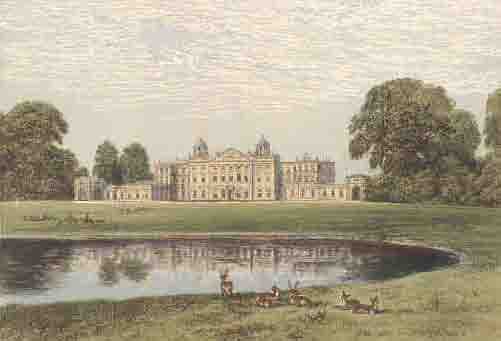I have nothing to say today. Actually, not quite true; I have a lot to say, but it’s in a new manuscript. I started this one Monday in a FastDraft I’m doing with some of the lovely ladies from NEORWA. I am woefully behind, so I am going to get back to it. My current scene features the hero and his long-lost sister, reunited, enjoying a picnic in a garden.
So, I will leave you with a recycled post on gardens that I originally wrote about this time last year, for the New Kids on the Writers Block.
(Just as an update, our front yard is now gorgeous, and the rose bushes are HUGE.)
Over the past two weeks, our front yard has been getting a makeover. We hired landscapers to rip out EVERYthing–trees, shrubs, 6-ft tall hedge from hell, grass, ground cover, front walk and steps. For over a week we waited for all the remaining foliage to die. (The neighbors thought we were completely nuts. Every time someone walked by, we would hear wafting through the open window, “Oh my God, they tore out everything! Do you think they are going to leave it this way?” Um, no.) We have now planted four ornamental trees, some ornamental grasses, roses, two tiny, well-mannered hedges, some lilies, and lots and lots of grass, which all require lots and lots of water.
When researching some possibilities for the plants to put in the front yard, I came across many, many references to English gardens. From the tiniest cottage garden to the most elaborate country house landscape, the English have been renowned for centuries for their garden design. Which got me thinking: gardens are marvelous additions to novels. They evoke scents–lush roses, heady lavender, sweet lilac–and vivid color. They feature marvelous little alcoves for a romantic tryst, or a secluded bower for intrigue. They provide a peaceful backdrop for a solitary walk, or a tree for a mischievous heroine to climb. So today I thought I’d take a little walk through the history of English gardens.
Over the years, styles of English gardens changed markedly. During the medieval period, gardens were typically enclosed by walls, and grew useful plants–herbs for cooking and medicine. They often had a mound inside, which was used to look outside the walls while remaining safely within. There is a lovely drawing of a medieval garden, as well as a discussion of what they may have looked like, here.
Some other resources for medieval gardens include:
http://www.godecookery.com/mtales/mtales16.htm
McLean, Teresa. Medieval English Gardens (Viking, 1981).
National Geographic story about a 2003 discovery of the remains of an unusual medieval garden at Whittington Castle.
During the Renaissance period, gardens were also enclosed, but they were much more elaborate. In the Tudor era, gardens were heavily influenced by Italianate style. The “knot garden” was developed during this period. Hampton Court Palace has several reconstructed Tudor-era gardens, including a classic knot garden.
The Stuarts, on the other hand, were into French gardens. These often featured a broad avenue flanked by rectangular parterres made of formal low hedges.
If you are interested in learning more about gardens of the Renaissance era, don’t bother Googling “Tudor Gardens” or “Renaissance Gardens,” as that leads to an astonishing number of urban American apartment complexes and nursing homes, few of which seem to have gardens. Instead, try searching on gardenvisit.com.
 |
|
Badminton House and landscape garden, Gloucestershire.
From Morris’s Country Seats (1880). Source: Wikipedia. |
The eighteenth century saw a shift to more natural looking landscapes. Achieving this natural look apparently involved removing everything that was in place (kind of like my yard), and starting from scratch. Every feature, including lakes, was then engineered to look as “natural” as possible.
Lancelot “Capability” Brown was the most sought-after landscape designer of the day. Brown is reputed to have designed over 170 gardens. For a biography of Brown and links to gardens still in existence today, go to http://www.britainexpress.com/History/bio/brown.htm.
Gardens in the Victorian period went a little nuts, with lots of flowers and exotic colors, and formal and informal styles mixed together. There are some wonderful photos at gardenvisit.com, which I am afraid to re-post here, due to copyright issues.
Some general resources on the history of English gardens, in no particular order:
*Great quick resource, and the starting point for this post: http://www.britainexpress.com/History/english-gardens.htm.
*Turner, Tom. Garden Design in the British Isles: History and styles since 1650. (1986?)
*The GardenDesign website has a great bibliography of books on garden design and landscaping history.
*Country Life’s website also has a wonderful post featuring links to the best sites for garden history, as well as some wonderful garden and landscape photos from its own archives.
*GoogleBooks has some wonderful free eBooks on English gardens written in the early 20th century.
*The best source I found during this little adventure was GardenVisit.com. Books, articles, photos–pretty much anything you might want to know about the history of gardens.
Finally, if you are a visual learner, check out http://www.gardenvisit.com/history_theory/garden_landscape_design_articles/historic_design_styles for illustrations of garden styles through history.
I hope you’ve enjoyed strolling through the garden with me. If you have any favorite garden resources, please do share!
Marin
